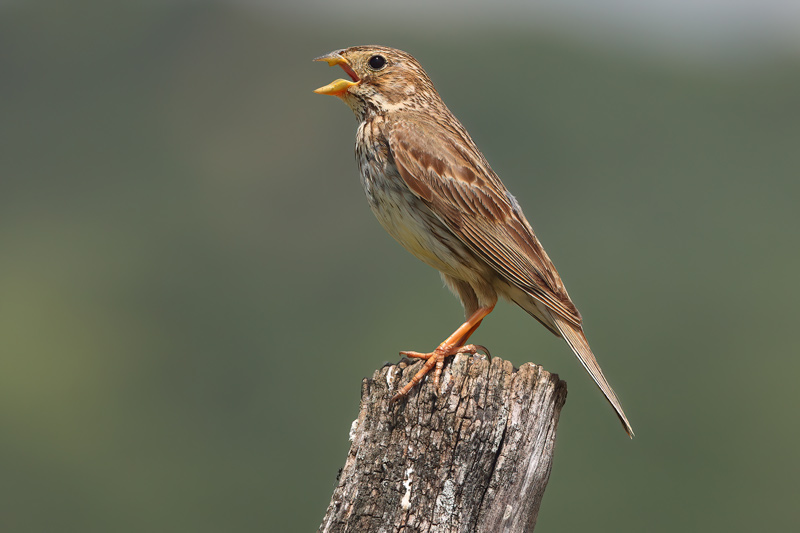Farmers across east Scotland have been praised for their efforts to get threatened corn buntings back from the brink.
Local farmers and estates have been praised for the continued improvement of the fortunes of corn buntings in across their last strongholds in Fife, Angus and northeast Scotland.
This year’s survey results, which were announced by RSPB Scotland today, revealed another record increase in corn bunting numbers in Fife and Angus, and also demonstrated how efforts to save the species have increased in the northeast.
In Fife, corn bunting numbers increased by 70% between 2014 and 2019, followed by another increase of 29% since 2020. There are now approximately 372 Fife corn bunting territories which means that numbers have more than tripled since their lowest point in 2001.
In Angus, numbers have increased by 82% in the same time period, and there are now 60 corn bunting territories in the area. This equates to a 233% increase since their lowest point in 2008.

Corn Bunting, copyright Glyn Sellors, from the surfbirds galleries
Overall figures are currently unavailable for northeast Scotland, however huge efforts have been made by many farmers to manage their land in a way to benefit corn buntings the most. RSPB Scotland has praised the dedication, passion and commitment of all those involved in the Corn Bunting Recovery Project across Scotland.
Yvonne Stephan is a Conservation Advisor for RSPB Scotland. She said, “Even after so many years, it’s amazing to see local farmers and landowners doing their best to help corn buntings. It’s heart-warming to see just how much effort has gone into bringing this little bird back from the brink, and how successful the management on participating farms has been. Assessing corn bunting numbers every year is a real joy as it reminds us of how many more chicks they have managed to raise successfully, and how many more adults are now making it through the winter. “
This continued good news comes after decades of dramatic declines for the UK corn bunting population. In eastern Scotland numbers fell by 83% between 1989 and 2007, earning them the unfortunate accolade of being one of the fastest declining birds in Scotland [note 1]. The combination of a late breeding season, a preference for nesting in growing crops and their dependence on the availability of cereal seeds over the winter and large insects in summer, makes corn buntings especially vulnerable to modern agricultural practices.
By providing winter seed food, safe nesting places and areas where adult birds can forage for food for their chicks on farms and estates, the Corn Bunting Recovery Project has contributed to changing the species’ fortunes in its last strongholds.
Farmers and land managers are using a combination of agri-environment scheme options, voluntary action and upgraded greening measures to help make the future of this iconic bird more secure, and have created over 1500ha of corn bunting nesting and feeding habitat within the last two years.
Over 100 farmers including the East Neuk Estates Group are currently taking action for corn buntings on their land. They are joined by two Fife golf courses, the Links Trust and the Crail Golfing Society, as well as local communities who are planting giant bird tables to provide food for corn buntings as well as yellowhammers, tree sparrows and skylarks over the winter. St Andrews University has started a new research project which should provide much more information about the Fife corn bunting population in the years to come.
Toby Anstruther and Sam Parsons from Balcaskie Estate, Fife, said: “Balcaskie and the East Neuk Estates are delighted to be involved in the success of the Corn Bunting Project, along with our neighbours and the RSPB. With practical advice from RSPB Conservation Advisors, we have combined AECS and greening measures to specifically benefit the species without affecting our rotation or land use. The cherry on the top has been a year-on-year increase in breeding territories, demonstrating the positive outcome of a co-ordinated landscape scale project.”
Chris Bailey, RSPB Scotland Advisory manager, said, “Everyone involved in the project is helping to ensure a sustainable recovery of corn buntings. While the success we are seeing is undoubtedly down to the enthusiasm and commitment of the farmers involved, it also points to the importance of having the right funding and measures in place to help deliver the work on the ground. As the Scottish Government continues to design a new funding package to support farming and help deliver on their vision for sustainable and regenerative agriculture, it is vital that this success is recognised, and future support enables this positive work to continue.“